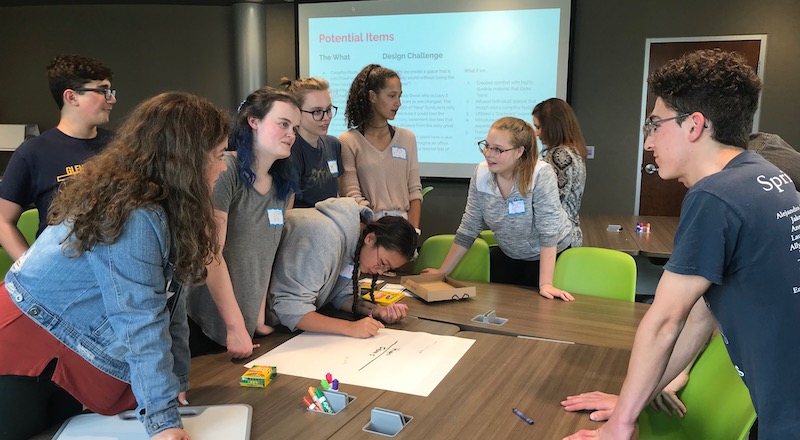There are so many variations to the creative skills that will help kids thrive in solving tomorrow’s challenges. Creativity is one of them and it envelopes many different subcategories students could consider while also monitoring the path the economy follows. To some, computational thinking is the most critical skill while, for others, design thinking is the most significant. This week, we’re focusing on the second, taking a close look at incorporating design thinking in K-12 schools and how developing this skill will benefit kids in their futures. It’s not just about designing creative solutions to problems in the classroom, either. Competencies in this area of creative thinking can also potentially help students create the very futures they want.
Design Thinking and Supporting Makerspaces
Besides integrating innovative teaching and thinking in education, another movement we’re very high on is the Maker Movement. Makerspace learning is often a great opportunity for students to leave their comfort zones and take part in hands-on, passion-based problem solving. Also, design thinking may even catalyze many of the successes kids attain in the makerspace. While they can design and complete so many unique projects in makerspaces, it’s not the outcomes that sometimes carry the most significance. You know what they say—it’s the journey, not the destination, that’s important. And, as kids work on makerspace projects, design thinking constantly comes into play—whether they realize it or not.
Infusing design thinking with play and empathy.
To create environments and experiences for kids to boost their design thinking skills, educators can start by focusing on play. This helps take some pressures out of learning and encourages kids to try new things in a relaxed atmosphere. Since makerspaces are fairly open environments, combining playing with design thinking is often easier to accomplish than in the classroom. Another way to promote it is in illustrating the importance of empathy in inventing. If students recognize how their projects could potentially help others, they might even alter and improve their designs. This also helps them consider all the aspects of a problem rather than just the end result. Also, thinking like an entrepreneur can help boost design thinking skills by getting students to think about how to construct a device or solution as a prototype.
Different approaches for different situations.
Makerspace experiences can also help guide students through the different phases of problem solving and how they might approach them. They can apply design thinking principles while they're building as well as to their failures and successes. Using this mindset can help kids see why one approach may have worked while another might have led to struggles. There are also different design thinking models that are effective in engaging students in maker learning and general problem solving. Overall, it can help students increase awareness of the problems around them and designing solutions. Through careful design, experimentation, and creation, they could achieve optimal results and boost problem solving development in the process.
Project-Based Learning and Design Thinking
Design thinking opportunities are largely hands-on, so, naturally, there are many ways to weave it into PBL. A lot of teachers have implemented project-based learning in their classrooms, which provides numerous benefits for students, including the chance to develop their design thinking skills. Usually, PBL is a long-term thing as opposed to quick projects that students complete in one or two class periods. Especially in middle and high school, it also ties in the community and solving pressing societal problems. Many times, these projects involve building something, which is why this thinking comes into play. Rather than building small-scale projects in their classes, however, PBL helps kids develop these skills while actually on the job.
Classroom design thinking examples.
Design thinking in PBL doesn’t have to be all physical work, however. Students can still apply their creative skills when utilizing computer programs, for example. If they’re researching something or perhaps even 3D printing some components to use in projects, they are more likely to use this process along the way. When visualizing themselves as designers, students will see how their solutions will unfold over a longer period of time—as opposed to simply getting the job done. Of course, this creates a lot more real-world relevance as STEM professionals are constantly accounting for both short- and long-term failures and successes. Plus, students can try new roles, experience leadership, and execute other team-based responsibilities.
A project-based approach to problem solving.
Project-based learning is also the perfect opportunity for students to reflect on why they did what they did. And, it just so happens that reflection ties in perfectly with this approach. When using design thinking, kids can go about solving problems in many ways but they should still be strategic. It's also a great opportunity for design thinking to come into play as students apply these concepts outside their classrooms. Don’t get us wrong—it is also a great way for them to master other 21st century concepts, too. Design thinking and PBL are also relevant in almost every academic subject—STEM or not—including ELA, science, SEL, and history. As you reflect on some new things to try, consider if design thinking and PBL might work.

Design Thinking and Problem Solving
In today’s educational climate, different teachers in different schools embrace different types of instruction, which has created a lot of variation in classroom environments. Some classrooms feature a lot of PBL while others include a whole lot of inquiry-based or personalized learning. All these various classroom types may help kids achieve different outcomes and allow them to explore new ideas. Also, they could put these skills to use in each environment while exploring these ideas and demonstrating understanding. It can also help them achieve a variety of big-picture goals while working to identify problems and creating solutions. And, educators can add design thinking in each of these environments—whether instruction is project-based, inquiry-based, or personalized.
Design thinking for students and others.
Teaching students about design thinking does more than simply helping them solve a problem. The design thinking process is structured, meaning there's more emphasis on students clearly identifying a problem, its major and minor elements, and how a potential solution might impact anyone involved. Since kids must prepare before beginning a project, this makes the lead-up and design thinking strategies more valuable. Plus, since design thinking projects often impact other people or groups, students tend to take them more seriously and enhance their quality of work. This helps them see that, for this particular project, their work is impacting someone else—helping them go beyond earning a grade or simply completing assignments.
What makes a good design thinker?
One interesting thing about design thinking in your classrooms is that—unlike other learning models—isn't always as linear. Students routinely have the opportunity revisit previous ideas or failed attempts in order to reconcile or improve them. This helps them better define problems and explore some opportunities to work towards a more clearly designed solution. As students use these strategies more regularly, it becomes less about the process and more about developing the proper mindsets for using it in everything they do. Good design thinkers can empathize, define, ideate, prototype, test, revise, and implement the best solutions for any situation given the factors they have to work with.
Design Thinking’s Place in the Classroom
For school leaders who love creating innovative learning opportunities, design thinking is commonly in the mix. To be the most prepared for the future, students should be able to solve problems in various contexts. Not surprisingly, this is where having these skills might serve them particularly well. Typically, there's more than one solution to a problem and the most efficient one may depend on the steps students take. Having a solid background in design thinking can certainly speed this process up and help lessen the chance that they overlook something. For this reason, design thinking—it would seem—can help students progress in just about any 21st century classroom.
Students and teachers growing together.
When pushed to utilize a design thinking approach in their problem solving, it’s not surprising that students tend to become better architects of that problem solving. This sense of independence also helps educators by allowing them to spend more time working directly with students who might need a bit more assistance. Ultimately, this kind of approach can get every student thinking and solving problems in this similar way. To sell the premise of design thinking, however, educators must fully believe in it and their ability to illustrate it. This helps students embrace the principles of design thinking and try to use this approach as often as they can. With a simple shift in mindset, educators can lead these kinds of changes in most classrooms.
Lesson planning to incorporate design thinking.
Design thinking is not just for students, though. The way that educators can impact student design thinking and the strategies they use in it is very unique. Like students, teachers can design their lessons with others in mind and consider how each student might react. This seems obvious but it doesn’t hurt to be reminded that, if one approach fails, you can try something else. The greatest benefit that design thinking provides to teachers, however, comes in their decision making. They have to decide what’s best for their lessons, their students, and even their classroom layout and seating arrangements. When teachers do this with purpose and help students activate design thinking, there's a greater chance they succeed.

Bringing Design Thinking to Schools
Guiding students towards utilizing design thinking can offer a lot of creative benefits and can certainly help them prepare for future problem solving. While this, simply on its own, can be accurate, design thinking in today’s schools adds other exciting elements to hands-on learning. One way educators can bring it into more of a focus is with maker learning or really any type of hands-on learning. By working with their hands, these kinds of disruptions to traditional instruction often help students realize their failures, successes, and opportunities to improve them. Basically, if teachers are free to move around their classroom and help kids, there’s a good chance those kids are employing some type of design thinking.
The teacher's role in fostering design thinking.
In fact, one common characteristic of classrooms with a lot of design thinking is the absence of a teacher’s desk. This kind of activity in 21st century classrooms creates a more circular pattern with teachers working with students and offering feedback rather than spewing information towards them. An analogy is thinking of teachers as more of conductors than someone who just recites information towards students. In design thinking classrooms, teachers also quickly begin finding new ways in which to learn. With many education leaders trying to move away from the sage-on-the-stage teaching model while keeping the teacher’s role prominent, hands-on, experiential learning is a common solution. And, in experiencing this type of learning, students can work on developing those specific design thinking skills.
Empowering students to think in new ways.
Traditionally, students think teachers have the answers to everything, but that's not necessarily something we'd want anymore. We want kids working with educators (or without) and finding solutions collaboratively rather than being told what's right. In terms of where education is going and future student responsibilities, this model certainly seems like it can be useful. As educators incorporate design thinking in activities, this could also unlock new ways of thinking, including computational thinking. Using meaningful challenges to get students and even teachers more active is definitely one way to highlight design thinking and a good starting point for students on their way to thinking like this in everything they do.
For the latest EdTech, STEM, and 21st century education news, follow us on Twitter and Instagram. Like us on Facebook, too, or sign up for our newsletter for our latest product announcements and offerings. If you have an idea for an Eduporium Weekly theme, send us a message on social media or comment below.



